Here at Barn Finds we sometimes run across sellers who, often unwittingly, pass off cars with older restorations as original condition cars. Automobile restoration was a popular hobby from the sixties through the eighties, and many of these cars were frequently used and exhibit honest signs of wear. Then, the original owner dies and the family, who has no interest in the car, passes it along with little knowledge of its history. For some cars, it is hard to tell without that history. Take for example this 1941 Packard 120 sedan being sold here on eBay out of Sandy, Utah. At first glance, it looks like a seventies restoration that has been hiding in a suburban garage for decades. On closer look, there are a number of clues that this may be a 72,000 mile original. With a buy it now price of $18,000, and a current bid of $5,100, is it possible that this may be a genuine original at a bargain price?
Before moving any further, something must be said for the car itself. Packards of this era are one of the most desirable driver’s cars a collector could want for. With a smooth straight eight engine, an overdrive transmission, supple suspension, and plenty of room in the comfortable passenger compartment, this car would be an absolute pleasure to drive on long trips, rallys, and tours. The seller tells us that it has been gone through and everything works. It needs a new set of tires badly, so the overdrive has not been tested out of fears for safety in case a tire blows at high speed. My first thought on a car like this would be to have a new set of tires added, make sure the gas tank and fuel system was properly tended to, have a mechanic look over the bearings, brakes, hoses, etc., and then drive it back home across the country. I don’t like the color, but I do like the car.
Looking past the color, we can see that the car has an assortment of little dents and scrapes as you scan the pictures above and below. The finish on the car is surprisingly shiny and deep. At first, I thought this was the typical seventies restoration paint job. However, I am not so sure. I do not see the typical cracking that many original finishes exhibit. However, this could have been a garaged car all of its life. The chrome is in very good shape, and there is little sun fading in the interior.
Looking at the passenger side, we can see that the finish has a fair amount of shine to the point you can see the reflection of the driveway in the car. I think the car would look better if the seller had installed the hubcaps before taking the pictures. A set of new wide whitewall tires might offset the dowdy look the car has as well.
Inside, we see that the plastic (probably bakelite) dash trim is in great shape. Early plastics were not very durable. Many old cars that used these plastics soon had cracks and shrinkage ruining the look of this trim. The wood graining on the dash and around the windows is in spectacular shape, as is the steering wheel. Restoring wood graining is frightfully expensive these days, and any prospective buyer can breathe a sigh of relief that refinishing these pieces will not be needed.
A look at the driver’s seat reveals some honest wear in the seat and seat base. Could this car have been reupholstered and worn from driving, or is this the original material? Notice also the service sticker on the door pillar and wear in the front carpet.
In the back, we can see a little wear in the seat material. You can also see some missing screws in the trim. The grab handle is still there, and there is some discoloration in the plastic on the door handle and the trim below. If anything is newer, my guess is that the carpet overlay is. It is a bit shiny in comparison to the rest of the interior.
A look under the hood reveals an engine that looks as if it never left the nest. The wear and tear on the paint covering the air cleaner certainly looks authentic, and the dust and grime build up would be hard to get to that level on a restored car. Pay special attention to the 643 written in chalk on the firewall. Is this a factory mark denoting the serial number of the car or body number?
Looking at this car as a whole, I do think it is an original car. If not, someone restored it in the seventies and then proceeded to drive it a whole lot. It is a four door, it needs some detail work and tires, but what a cruiser for someone who can see beyond all that. I wish I could put it in my garage.
Do you think it is original?

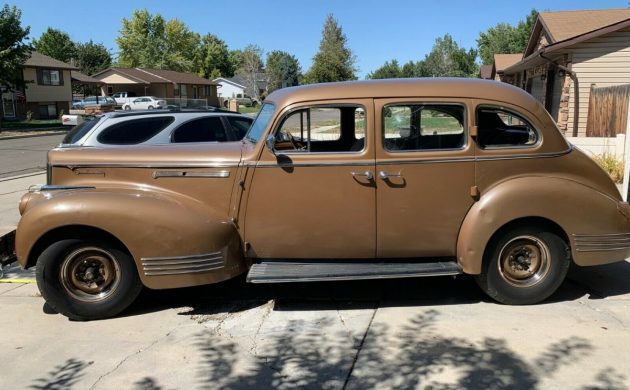
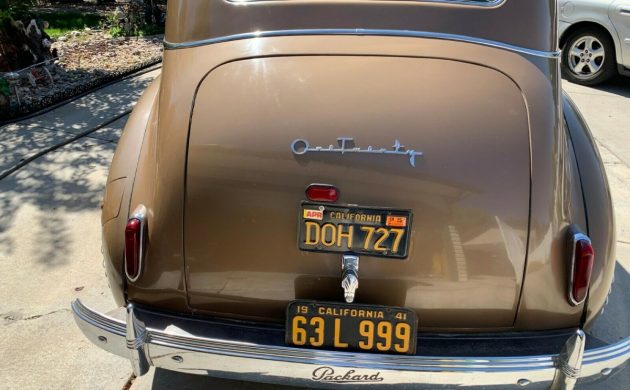
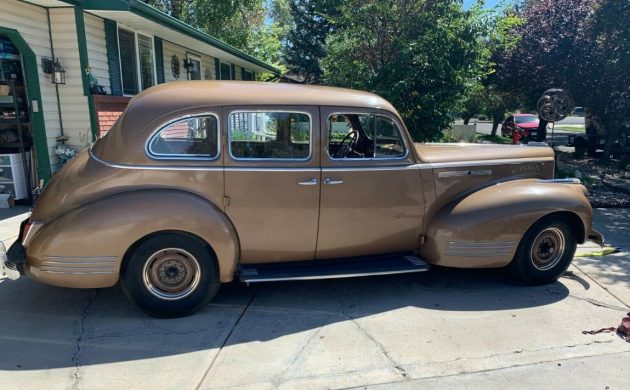
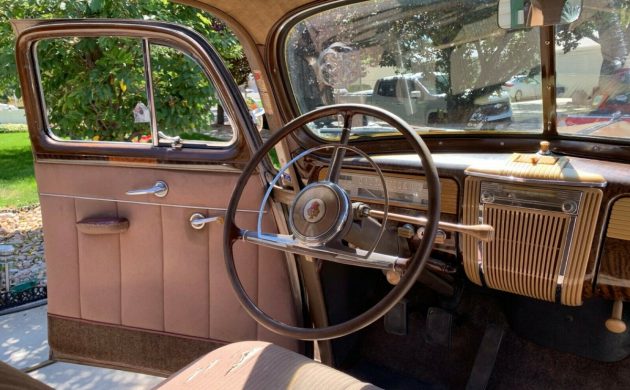
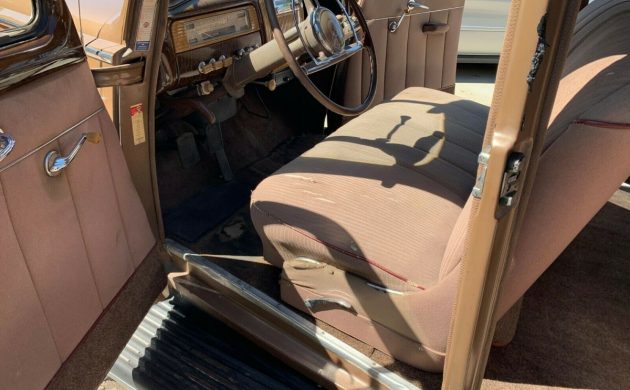

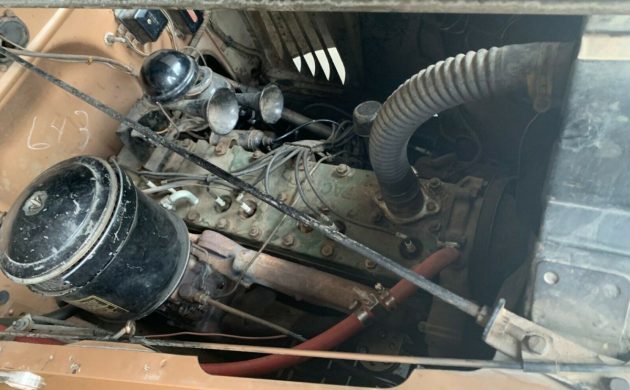


Nice one, Jeff! I love Packards, and it’s fascinating to think an original car could look this good. Growing up we had a 1940 Plymouth, roughly the same body style, and the similarities to this Packard are striking, though this is clearly a step up in every area. I remember my friends saying the seats were like “a couch from my grandma’s house,” and you could stand a half keg up in the trunk (maybe two) and close the lid. I even took the Plymouth to prom, but I’d have loved to have had a Packard like this instead. Thanks for the memories!
Jeff, I sure enjoyed reading about this old Packard 120 sedan with it’s suicide rear doors. This is one of those cars that I love to admire in someone else’s driveway, garage or at a car show, but have no desire to ever own. It was obviously someone’s pride and joy at one time. I think it’s an original unrestored mileage as claimed Packard 120 with maybe a few things done along the way. I hope a BF’s member or reader here can enlighten us all on the “643” written on the firewall.
Color is Saratoga Beige, I presume. Hard to really see the paint looking at pictures on my phone but it certainly could be original. What a neat car, very classy.
Someone is going to get a good deal. 120 may be the entry level Packard, but it is still superior to most vehicles of this time.
The six cylinder “110” was still around in ’41- it was the entry level car. The 120 had that big, smooth straight eight.
A company I wish was still building car’s today.
Fred, thanks for the correction.
Great write up Mr. Jeff. Packards are the reason we say they don’t make em like they used to. I always respected their attitude that you don’t change it for any reason but improvement.
“643” may be the interior trim code to tell the assembly line workers what color seats and interior panels need to go into the car after it is painted. That’s just a guess. I’m no Packard authority, but if it were a Buick, that would be the interior trim code.
It’s a 6,not an 8 cylinder.
Definitely an 8; the last plug is not visible behind the air cleaner, but the wire to it is.
Question: Does one long-ago repaint qualify as a restoration? (Personally, I don’t think so.)
I agree, it is an 8.
Was it worth the $18,000 Buy It Now? Ask the (wo)man who now owns one!
Yes. The overdrive alone adds quite a bit of value. Also adds quite a bit of gas mileage on long cruises.
If this is a repaint, it was well done, which is rare for a 70s repaint.
You will probably need to replace the door seals. Steele Rubber carries them.
redwagon – Congrats if you are the new owner. I happen to really like it, and have a warm spot in my heart for Packards. First car I remember as a small kid. My Dad owned a ’47 that was two-toned. Most of body medium tan, roof and fenders dark brown & tan cloth interior. He was a big guy and that was a big car. Straight 8 as well. I vividly remember crawling up into the well below the back window and falling asleep there when we went for rides. Wow….
Nice car. I used to see one at Killeen, Texas back in the early 80’s. That one was black. I never had the opportunity to talk to the owner, as I would see him driving on the highway. He was probably a military man stationed at Ft. Hood. It was a car that really caught my eye. Packard was the first company to offer air conditioning, the year was 1940.
God bless America
Dear writer,
Your statement “the most desirable driver’s cars a collector could want for” is either fortunately or unfortunately wrong for if this truly was “the most desirable driver’s cars a collector could want for” the price would be far higher. Unfortunate for the seller, fortunate for the man who appreciates it. I put the Bentley Mark VI and R Type in the same category, truly remarkable cars, absolute joy to drive but overlooked and unappreciated by the car community in general.
As someone who has owned a couple of hundred Packard cars over the last 50+ years, I feel confident to say this appears to be an honest low-mileage mostly original car
If it’s out of utah, i would want to check underneath for rust because they have some pretty harsh winters there. And why does it have 2 different ca. Plates? Nice care. But a little steep in price, because your going to have to put a few dollars into it.
NADA Guides says worth 15 to 26 grand.
This is a darn nice example.
Sweet Packard, and while I would not pick this color it’s fairly typical of the era. Most of the La Salles I’ve seen from this time, contenders for the same market segment, have been a rich brown or lighter tan. I think it fits the car very well, and would not want to change it.
This is my favorite year for Packards anyway, and not just because that was my introductory year as well. I’m no longer particularly interested in the Clippers and their look that took over all Packards from ’42 until the Fifties, and I think 1941 was the year for the best-looking separate-fender Packards. Mr. Darrin really outdid himself, with his handsomest cars ever until the ’50s Kaisers.
I sold a 41 Packard 110 (6cyl) a year ago, it was an all original 1 owner car with 83k miles. The paint on mine was not this nice but the instrument panel and engine compartment were probably better. I would agree, this could be an original car.
Just plain cool!!! An American classic!!!!
This would be a great car for a Homer Simpson fan.